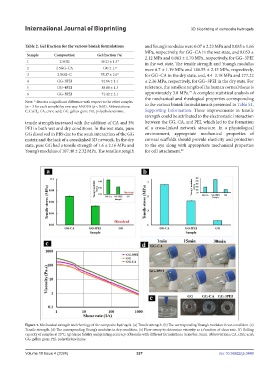Page 335 - IJB-10-4
P. 335
International Journal of Bioprinting 3D bioprinting of composite hydrogels
Table 2. Gel fraction for the various bioink formulations and Young’s modulus were 0.07 ± 2.23 MPa and 0.085 ± 1.66
MPa, respectively, for GG–CA in the wet state, and 0.053 ±
Sample Composition Gel fraction (%) 2.12 MPa and 0.063 ± 1.70 MPa, respectively, for GG–3PEI
1 2.5GG 49.21 ± 1.3* in the wet state. The tensile strength and Young’s modulus
2 2.5GG–CA 100 ± 1.7 were 6.7 ± 1.19 MPa and 146.55 ± 2.15 MPa, respectively,
3 2.5GG–C 55.37 ± 2.0* for GG–CA in the dry state, and, 4.4 2.18 MPa and 277.22
4 GG–3PEI 91.66 ± 1.1 ± 2.36 MPa, respectively, for GG–3PEI in the dry state. For
5 GG–4PEI 88.88 ± 1.3 reference, the tensile strength of the human corneal tissue is
79
6 GG–5PEI 71.42 ± 2.1 approximately 3.8 MPa. A complete statistical analysis of
the mechanical and rheological properties corresponding
Note: * denotes a significant difference with respect to the other samples to the various bioink formulations is presented in Table S1,
(n = 3 for each sample) by one-way ANOVA (p < 0.05). Abbreviations:
C, CaCl ; CA, citric acid; GG, gellan-gum; PEI, polyethyleneimine. Supporting Information. These improvements in tensile
2
strength could be attributed to the electrostatic interaction
tensile strength increased with the addition of CA and 3% between the GG, CA, and PEI, which led to the formation
PEI in both wet and dry conditions. In the wet state, pure of a cross-linked network structure. In a physiological
GG dissolved in PBS due to the weak interaction of the GG environment, appropriate mechanical properties of
matrix and the lack of a crosslinked 3D network. In the dry corneal scaffolds should provide elasticity and protection
state, pure GG had a tensile strength of 1.6 ± 2.16 MPa and to the eye along with appropriate mechanical properties
Young’s modulus of 107.48 ± 2.32 MPa. The tensile strength for cell attachment. 80
Figure 4. Mechanical strength and rheology of the composite hydrogels. (a) Tensile strength. (b) The corresponding Young’s modulus in wet condition. (c)
Tensile strength. (d) The corresponding Young’s modulus in dry condition. (e) Flow sweep to determine viscosity as a function of shear rate. (f) Gelling
capacity of samples at 25°C. (g) Shape fidelity and printing accuracy of bioinks with different formulations. Scale bar: 5mm. Abbreviations: CA, citric acid;
GG, gellan gum; PEI, polyethyleneimine.
Volume 10 Issue 4 (2024) 327 doi: 10.36922/ijb.3440

